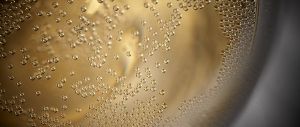BLOG
Champagne glass
A BIT OF WINE CHEMISTRY: Lessons from Champagne Day one of the Champagne study trip initiated a discussion which continued throughout the week of factors impacting aromas and flavors in champagne. Broadly, aromas can be categorized into the impacts of grape variety, terroir, vinification, and post-production events (influencing individual bottles versus entire “batches”). This article will focus upon the biochemistry of sulfur, nitrogen, oxygen, and sugars in an acidic environment (esters arising from acidification of alcohol); the intent is not intended to be comprehensive. For purposes of this essay, the use of the word aroma will include the complex notes of aging characterized as “bouquet.” “Although many efforts have been made to characterize the quality and flavor of the compounds in wine… tasting remains the single universal test used… This is because the taste of a molecule, or blend of molecules, is constructed within the brain of a taster.” F. Brochet and D. Dubourdieu, 2001

